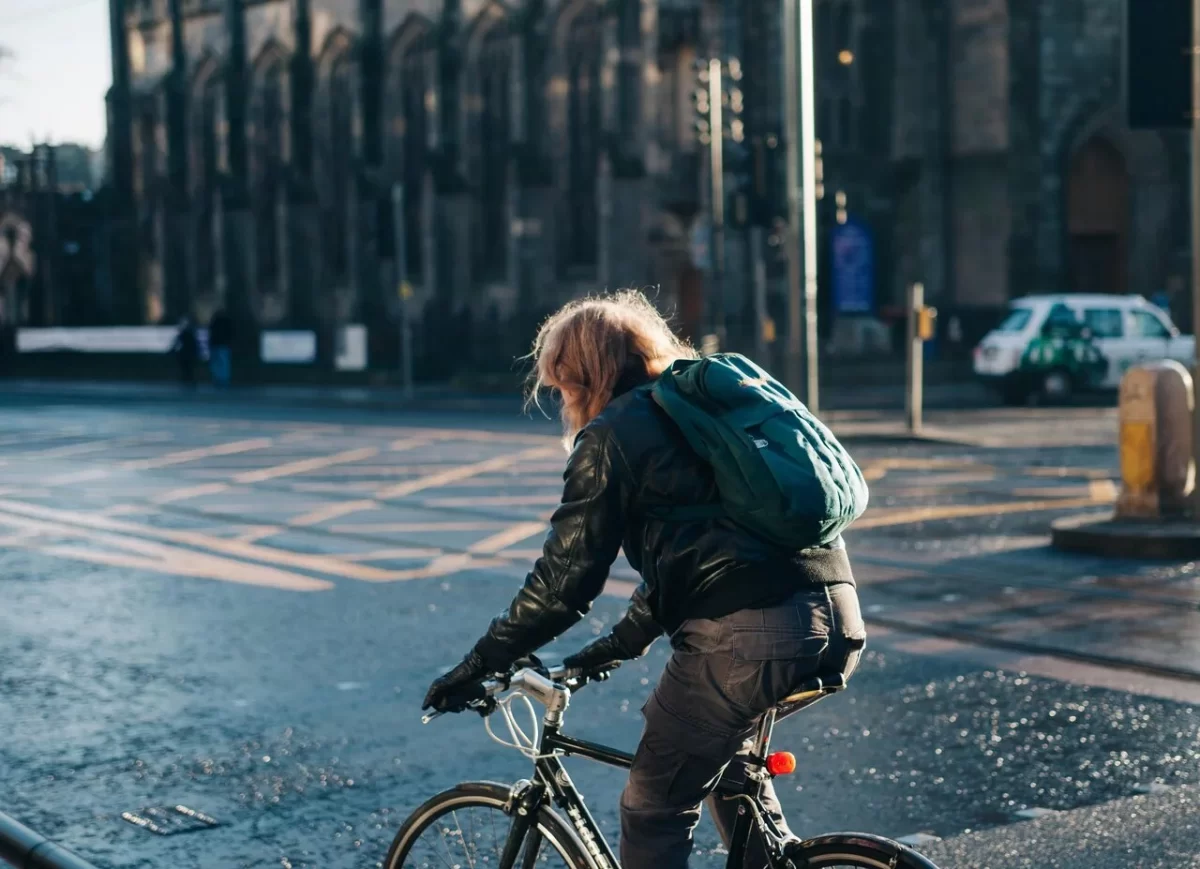You may be considering starting using a bike to commute to work or school, but you’re still not sure how long it would take you to reach your destination. So what speed can you expect on a daily basis?
On average, urban cycling has a speed of 19-26 km/h or 12-16 mph. A lot of factors such as distance, stop signs, red lights, intersections, and traffic may affect your average daily commute duration. Cities can be very different, and the available bike roads and the time of day can have a great effect on your expected speed.
To get a better idea of the actual average speed of urban cyclists in their daily commute, I looked at posts on BikeForums and RoadBikeReview where cyclists have responded with their average speeds. All of the answers were from people who have been using bikes in their commute for a relatively long period. I gathered a total of 87 responses which showed speeds that varied between 14 and 29 km/h (9-18 mph) with an average of 23 km/h (14.3 mph). Keep in mind that the large variation is due to differences in routes, traffic, lights, road conditions, distances, and weather.
That is still a small sample size, so what happens when you look at average speeds globally? In Copenhagen, a city of cyclists, the average cycling speed is 15.5 km/h or 9.6 mph (Source). Strava, a social fitness network that is used by athletes to track their rides and runs, publishes its data regularly. In 2018, the yearly review showed an average global speed of 21.7 km/hr (13.5 mph). This data was collected from the 287.5 million rides that Strava tracked that year (Source).
What is the average cycling speed for beginners?
Beginners can expect to ride at average speeds of 16-22 km/h (10-14 mph). When you first start, your speed will be affected by your fitness level. Other factors may include your age, sex, weight, and the quality of your bike. Try to aim for anything above 19 km/h (12 mph) when you start. Your average speed will increase as you develop your cardiovascular capacity and lower body strength with time.
More experienced cyclists can average speeds of 24-29 km/hr (15-18 mph). Reasonably fit cyclists can reach speeds of 40 km/h (25 mph) with racing bikes, and professional cyclists are able to maintain speeds of 40-45 km/h (25-28 mph) on flat surfaces.
How do I improve my cycling speed?
The most efficient ways to improve cycling speeds have to do with combating air resistance. About 80% of your energy is used to battle air resistance when you cycle. So how do you do that? Simply put, you become more aerodynamic. You can achieve that by improving your body position on the bike and wearing more aerodynamic clothes.
When it comes to your body position and shape, there are three simple tips you should keep in mind:
- Your back should be flat with a low and long reach to the handlebars. This means your back cannot be hunched or curved.
- Your shoulders should be tucked in to keep your arms in front of your knees.
- Your head should be low and in line with your back. Try glancing up with your eyes instead of raising your head.

What cycling gear do I need to get started?
You may be wondering what you need to wear to start cycling. Other than some comfortable sportswear and a helmet, you don’t really need much to get started. After all, you’re going to be using your bike for commute and not for racing other cyclists over long distances. If you do want to get fancy, however, there are a lot of options for cycling wear and gear.
Cycling jerseys can reduce drag while keeping you dry and long-sleeve ones can keep you warm. You’ll also want bike shorts or tights depending on the weather. Consider wearing shoes that have a “sport” style. These keep you feeling comfortable when cycling but also look nice at the office. Sport socks are also a great addition. Finally, I recommend using gloves with short-cut fingers in the summer to keep your hands from getting sweaty. In winter, you’ll want breathable full-finger gloves to keep your fingers and hands warm.
How do I freshen up after cycling to work?
Giving yourself enough time to get to work or school can be the best thing you can do. By going slow and keeping your heart rate low, you can avoid breaking a sweat. You can then go faster on your way back home to improve your fitness level.
If that is not an option, here is my advice:
- Wear cycling clothes and keep your work clothes separate so you can change when you get there.
- Baby wipes can be a lifesaver. Use them on your face and underarms.
- Wipe away excess moisture with a towel.
- Apply some deodorant when you’re done.
Is cycling to work enough exercise?
Biking to work can be enough exercise if your work is far enough. The American Heart Association recommends 150 minutes of moderate exercise every week (Source). This can be easily achieved by cycling for 30 minutes 5 days a week at a speed of about 16 km/h (10 mph). If you cycle at higher speeds, the exercise can become vigorous and 100 minutes a week might be enough.
A lot of studies have discussed the effects of leading a sedentary life and how it can adversely affect your health over long periods of time. Similarly, the benefits of exercisi a few times every week can be life-changing. By following the American Heart Association recommendations, you are effectively lowering your risk of heart disease, stroke, type 2 diabetes, high blood pressure, dementia, and Alzheimer’s.
What are cycling safety rules and etiquette?
- Always use bike lanes when available and stay to the left side of the lane.
- Never ride against traffic. You should always ride in the same direction of traffic. Riding against traffic is both dangerous and illegal.
- Use the entire lane if necessary. It might be safer to move to the center of the lane if it’s too narrow for drivers to pass safely.
- Don’t ride on pedestrian sidewalks. If you have to, slow down to walking speed and be careful.
- Stay away from parked cars. Keep at least 1 m (3 ft) between you and parked cars to avoid doors.
- Stay aware of your surroundings. If you like listening to music, only use headphones on one ear.
How does cycling help the environment?
Cycling is a pollution-free mode of transport. The fact that there are no gas emissions from riding a bike makes it an environmentally friendly option. But that’s not all. By choosing to ride a bike on your daily commute, you are reducing the traffic in your city; another major factor that adds to emissions. Finally, by staying off the road you reduce the need for your space and therefore bigger roads. That means fewer resources for building highways, more open spaces, and more green areas that stay untouched.
Why is riding a bike better than driving?

Bicycles take less material to make than cars. Cars are complicated pieces of machinery that use a huge variety of materials when made. Metals such as steel, aluminum, and copper are used to make the car frame, radiator, and electrical wires. Windshields and windows are made from glass. Body panels, dashboards, fenders, and several other parts are made from plastic. Tires and hoses are made from rubber, and lead is used for making batteries. In addition, the manufacturing process itself requires a lot of energy. To give you a little perspective, consider the fact that it takes 7 gallons of oil to make a single rubber tire.
Bicycles reduce emissions. When you choose to not drive, you are removing the impact that would have resulted from all of your car’s emissions. As I’ve mentioned earlier, you are also reducing traffic and the need for bigger roads. According to the EPA, the average passenger vehicle emits 4.6 metric tons (10141 pounds) of carbon dioxide annually (Source). But carbon dioxide, although emitted in higher quantities, is not the only greenhouse gas coming from your car. Smaller quantities of nitrous oxide and methane are also emitted. Due to their higher global warming potential, they can have a greater impact on the climate.

